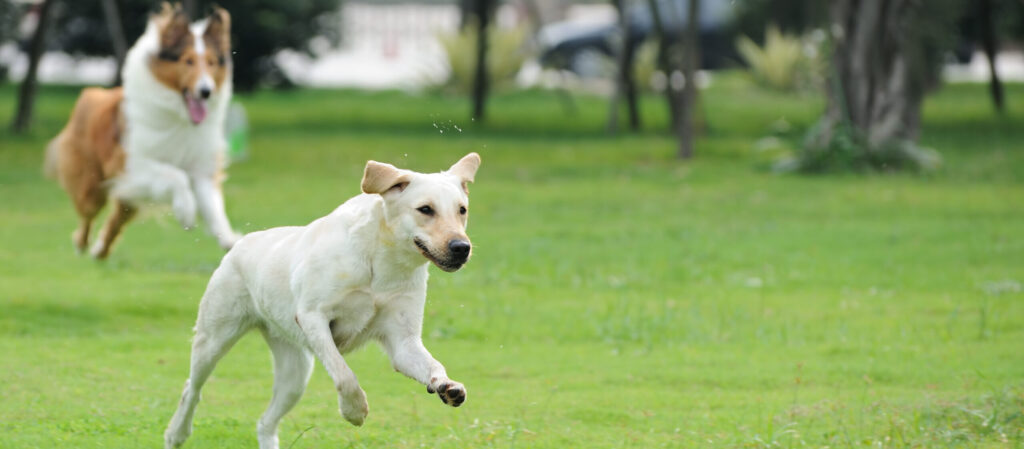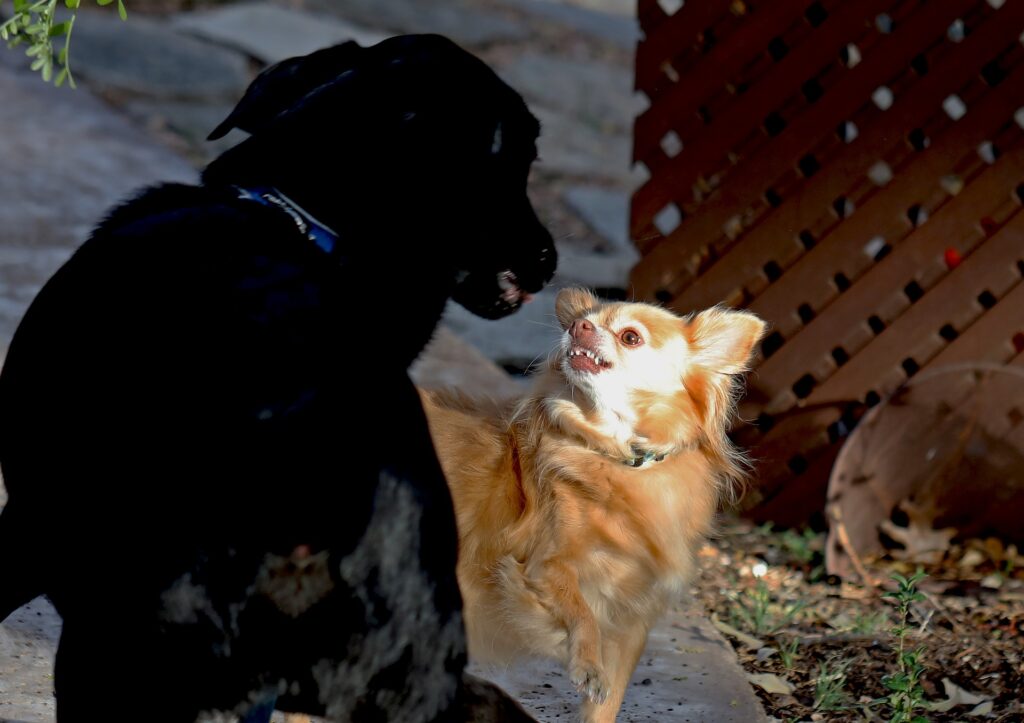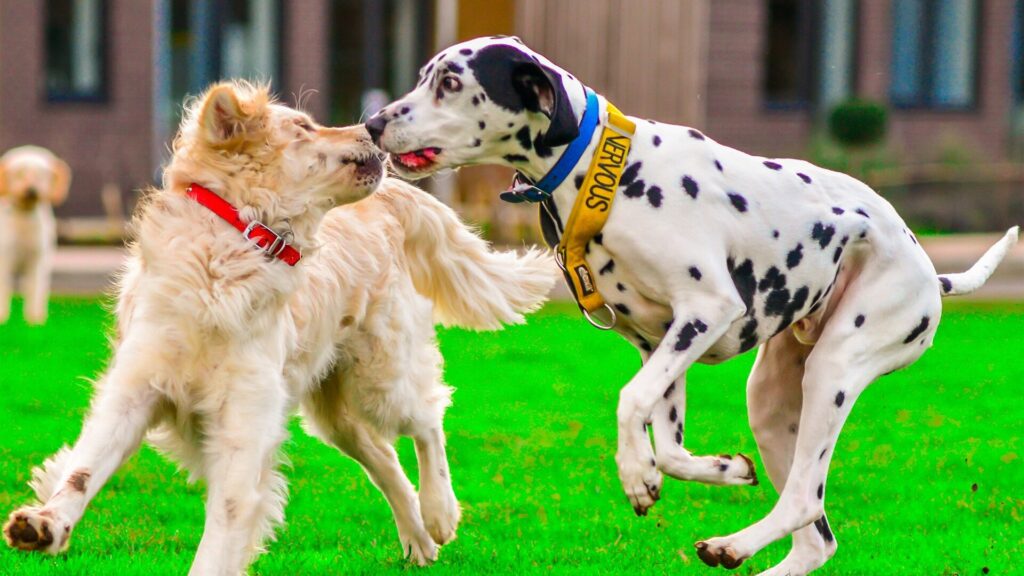Dog parks are wonderful in concept for your typical urban dog. Many dogs who live in an urban environment can get very little off leash time due to safety. These dogs often live in apartments that are smaller and so can’t play in a yard of their own. Having a community dog park can provide a much needed outlet for those dogs, giving them the space to roam and interact off leash with other dogs.
But dog parks come with their own risks. While rules can be stated at the gate on a sign put up by the community, it tends to fall on the people in the dog park to enforce said rules.
At most community dog parks there are two big risks:
- Dog fights, scuffles, and aggression:
- Many people don’t have the knowledge background when it comes to things like dog body language to figure out if their dog is interacting well with other dogs. This skill set is learned and while some more experienced dog people can spot when something is wrong, learning the specifics of early warning signs of stress and conflict between dogs is better taught directly.
- Many people don’t have the knowledge background when it comes to things like dog body language to figure out if their dog is interacting well with other dogs. This skill set is learned and while some more experienced dog people can spot when something is wrong, learning the specifics of early warning signs of stress and conflict between dogs is better taught directly.
- Vaccine and health status:
- It’s hard to enforce vaccine status. While dogs are required to be vaccinated at most dog parks as stated by the park’s rules, you have to trust your fellow community members to vaccinate since no one is there to check. This can be a problem when a dog shows up who has lapsed on their vaccines or who hasn’t had them at all. Core vaccines help keep dogs in communities safe by lowering the spread of fatal diseases, like Parvo Virus. While vaccinating your own dog will keep them safer, some diseases travel home with you to your community on your shoes and spread to more places, making your home area less safe for puppies who are not fully vaccinated yet or elderly dogs with weaker immune systems.
These typical risks in dog parks cause the most concern. When it comes to altercations between dogs, it can be difficult to manage the situation and resolve it. It takes a lot of bravado to approach a person at the dog park and tell them their dog is causing problems before a fight actually breaks out. This puts community members in conflict with each other and people get defensive about their dogs on both sides.
You may be wondering if there are alternatives to the community dog park. Maybe you’ve noticed your dog likes the social interaction, or the wide-open space, but the risks make you feel too uncomfortable.
The good news is there are alternatives that are lower-risk. It is important to note that dog-dog play always carries risk, even if that risk is minimal. However, while nothing can ever be risk-free, it’s good to know what you can do to meet your dog’s needs while ensuring they are the safest they can be.
Doggy Daycare:

If your dog craves that high intensity play and is a social butterfly, doggy daycare could be a safer alternative to their regular romps at the community dog park. You want to make sure you take the time to shop around for the right doggy daycare (see our article here for important information), but when you find the right one, letting your dog have a playdate in a safer environment is best.
Good doggy daycares train their staff on managing a group of dogs for safe play interactions. Staff are trained on dog body language, de-escalation techniques, dog play styles, and get to know their regular dogs well who come to play.
Doggy daycares also require vaccines for dogs, making your dog and your community safer.
Most dogs don’t need daycare everyday, and they may not even need a full day of daycare to get their play needs met. Doing half-days and spreading out visits to about three times a week is sometimes all dogs need to get their social and play enrichment. Make sure to look at your dog in particular when deciding how often and how long to leave them in daycare. If you have concerns, talk to your trainer about whether this option is best or how to notice warning signs of burnout in your dog.
Pros:
- Trained staff to handle and manage safe dog play and interactions
- Vaccines required for dogs’ safety and health
Cons:
- You can’t stay with your dog while they play
- May be too overstimulating for some dogs. Not all dogs love doggy daycare.
- While risk is mitigated in the controlled environment and with temperament testing, there is still possibility for dog altercations
Sniffspot:

We’ve all heard of Airbnb. Now imagine Airbnb for your own private dog park. Sniffspot is a website/app that allows people to rent out their backyards and other outdoor spaces for dogs and their humans to come play. This service is first and foremost made for dogs who struggle to be around new people and/or dogs. The app allows you to look at tons of information about a spot, including how high the fencing is, if it is fully or partially fenced, if there are people or other dogs on or near the property, and what amenities there are.
Some spots are set up simply and are just a fenced backyard with some water and a good space to play. Others get fancier, providing swimming spots, agility equipment, or fenced-in acreage you can hike on with your dog off leash. There are even creative enrichment opportunities sometimes like “Dog libraries” that are filled with fun sticks.
You can rent spaces by the hour and most places have a per-dog per-hour pricing structure. The time slots are even set up to make sure when you leave that there is a gap in time before the next dog arrives, meaning dogs never have to cross paths with other unfamiliar dogs or people. So if your dog needs a new space to get the zoomies out, play, and get some new smells, but isn’t super keen on unfamiliar dogs or people, this can be a great option.
When it comes to vaccines, as a company, Sniffspot requires dogs to be up to date on certain core vaccines as well as flea and parasite preventative. However, guests self-certify their dog’s medical status before using services and agree to provide proof if required. This means that it is up to the hosts of the spots to keep visitors accountable for vaccine status.
So when looking into these services, just like with Airbnb, doing your due diligence is recommended.
Pros:
- Private dog park opportunities: good for dogs who want a park but maybe don’t do well with other dogs
- Set up for dogs who need space: appointment times don’t overlap with other dogs and spots have detailed information about what’s in the area
- You get to stay with your dog and play
Cons:
- Due diligence is needed when it comes to hazards, vaccination and health status, and upkeep of the spot.
Monitored dog parks:

If you’ve been following the latest trends, you may have noticed an uptick in dog park bars. This recent trend brings the best of both the doggy daycare world and the dog park world. These dog park bars allow people to be in the dog park with their dogs while having staff members on site who monitor the dogs during play. These places also have patios where on leash dogs can hang out with their people to get food and drinks, as well as indoor spaces for humans to dine.
If you’re looking for a place to hang out with your dog while they play, a monitored dog park might be right for you. These places do require a fee for dog entry, but don’t charge an entry fee for humans. Humans are even encouraged to go check the place out without their dog to see if it would be a good fit for them.
Monitored dog parks also require up to date vaccines, which means disease risk is much lower. Staff being in the park allows you to relax a bit more knowing there’s a dog savvy person who is there to look out for the pups, help deter altercations, and let parents know when their dog might need a break on the patio or if it’s time to go home for the day.
If you’d like to look at dog park bars in the Oklahoma City area, we currently have two. Solo’s Park and Pub is located in Chisholm Creek on the north end of the city near Edmond, while BarK is located near Scissortail Park.
Pros:
- Dogs are monitored by staff to make sure everyone is having a good time for safer play
- Great for dogs who like to get that dog park experience and enjoy playing with other dogs
- You can stay with your dog while they play and play with them
Cons:
- Could be overwhelming for dogs who don’t like a lot of action
- While risk is mitigated through staff management and training, there is still potential for altercations
Paid membership dog parks:

These dog parks are becoming more popular slowly. The idea is that people must apply for a key fob for entry to the dog park and submit health records as well as answer behavioral questions for their dogs. While these dog parks are not directly monitored by staff, patrons must abide by rules or risk losing access to the dog park.
These parks tend to be cheaper for entry than monitored dog parks and so can be a more cost-effective option. Members also tend to get to know each other better since they are a part of a group and they all have not only a paid investment in maintaining the park but also a desire to be in a safer dog park for everyone.
The downsides to paid membership dog parks is making sure rules are enforced by the members of the dog park and that it is easy for the community to reach out to those in charge when there are problems. Unfortunately, people can be unaware of the problems their dogs possess and with good intentions think their dog doesn’t display aggressive or fearful tendencies.
This can lead to dogs who are inappropriate for dog-dog play entering these spaces, unless there is a temperament evaluation done by a professional. And even then, dogs can have experiences in their development later that cause problems to emerge if they are not regularly evaluated.
So while this option could be better, it’s typically more risky than a monitored dog park, doggy daycare, or a sniffspot. It’s still important to practice due diligence.
If you are looking for a paid membership dog park in the OKC area, we currently have one near Lake Hefner. Paw OK Dog Park is operated by an all-volunteer nonprofit and is funded through membership donations. They require dogs to be non-aggressive, spayed or neutered, and have proof of vaccinations submitted. Potential members apply for membership on their website. At the bottom of their user’s fee page on their website, they encourage all users to take their dogs to obedience training and have their dogs’ temperament evaluated before becoming an annual donor.
Pros:
- Dog vaccines are required to stay in date, creating less risk for disease.
- Dogs can play with each other
- You can stay and play with your dog
- If well run, there are behavioral questionnaires for application and people agree to the same set of rules before getting a key for entry
Cons:
- Well-intentioned dog parents can still mistake their dog’s temperament and behavior towards other dogs as acceptable or friendly when it is not
- Dog-dog play carries risk for altercations or injuries
Playdate:

If you have a yard and your dog has friends already, setting up a playdate can be a wonderful way to meet their needs. Dogs who are familiar with each other and don’t mind other dogs visiting their territory can have a great time together without the need to go anywhere special.
This option is good for very young puppies who are in the process of getting their vaccines and would benefit from a healthy, fully-vaccinated, and well-socialized dog to play with. Most places do not allow puppies who are not fully vaccinated on their grounds since their risk of picking up deadly diseases is much higher.
Dogs who are dog selective, but do have some good dog friends, could also benefit from this setup as well.
If you are curious if your dog could be a good friend with another dog but don’t know how to safely introduce them, talk with your trainer about best practices. Guidance from a professional who knows your dog well can help you set up a social encounter for success and prevent common problems. Just putting two dogs in a backyard and letting them work it out is typically not the best way to go.
The biggest issue most people run into with this option is not knowing who might be a good friend for their dog or how to get started. It’s easier if you’ve had opportunities to meet potential friends, like in training class or at your dog’s doggy daycare. It can be much harder when you know few people with dogs, or you know many but the dogs are not very dog-social or savvy.
Still, setting up playdates allows you to control more parts of the interaction and environment to make sure everyone stays safe and has fun.
Pros:
- You get to stay with your dog while they play
- Great for dogs who already have dog friends and just need some time to play
- You can more easily get to know the dogs coming to play
- No membership fee or day pass fee is required
- Great for puppies who need to be more careful with their health
Cons:
- This requires you or your dog’s friend to have a space to play in, which may not be accessible to everyone
- You may not have any dog friends for your dog already, don’t know how to introduce your dog safely yet to new friends, or don’t have access to well-socialized dogs
- Not great for dogs who struggle with people or dogs in their territory, even familiar ones
Longline adventure walks:

Many of us as trainers like to do this with our own dogs. This kind of walk involves going to a big area, like a field, and letting your dog sniff and explore on a long leash. Longline adventure walks can be a great way to get your dog some exercise without having a fenced yard.
This adventure is not recommended for dog-dog play as lines can get tangled, but is great for those who want to let their dog be a dog without the constraints of a six foot leash in the neighborhood.
There are a few key factors to consider when preparing for your longline adventure walk:
- Pick an area that is free of as many tangling hazards as possible.
- Look out for shrubs, trees, and poles.
- Look out for shrubs, trees, and poles.
- Pick an area your dog is allowed to be in with you.
- There are many great fields out there, but they are not all public property! Make sure you have permission to be there.
- There are many great fields out there, but they are not all public property! Make sure you have permission to be there.
- Be mindful of walkways and traffic.
- Do not let your line drag in areas where it can be a tripping hazard to those around you. It’s important to make sure that your dog stops a reasonable distance from people and is not allowed to introduce themselves to others without explicit consent. Not everyone, or their dogs, likes strange dogs running up to them.
- Do not let your line drag in areas where it can be a tripping hazard to those around you. It’s important to make sure that your dog stops a reasonable distance from people and is not allowed to introduce themselves to others without explicit consent. Not everyone, or their dogs, likes strange dogs running up to them.
- Be considerate of public space.
- Everyone is allowed to enjoy the space you are going to use with your dog. If someone has set up a game or picnic in an area, give them space to enjoy the park and don’t let your dog encroach.
- Everyone is allowed to enjoy the space you are going to use with your dog. If someone has set up a game or picnic in an area, give them space to enjoy the park and don’t let your dog encroach.
- Know how to safely use your longline.
- If you are unsure how to safely use your longline, talk to your trainer about technique.
- If you are unsure how to safely use your longline, talk to your trainer about technique.
- Bring training aids with you.
- Having training aids with you like treats or toys can help you reward your dog for good behavior or encourage them to stay with you if needed.
- Having training aids with you like treats or toys can help you reward your dog for good behavior or encourage them to stay with you if needed.
- Have a practiced recall.
- Practicing recall at home first can help get you and your dog out of a jam. Taking it to the park where there are more distractions will take some time to teach. If you need help training your dog to recall with more distractions, talk to your trainer about options.
- Practicing recall at home first can help get you and your dog out of a jam. Taking it to the park where there are more distractions will take some time to teach. If you need help training your dog to recall with more distractions, talk to your trainer about options.
- Have a practiced leave it and drop cue.
- Teaching your dog to leave things alone or drop them is good for any space you take your dog in, but especially in spaces where they may wander farther away from you and find something you can’t see from where you are at first. If you need help training your dog to leave it and drop, talk to your trainer about options.
- Teaching your dog to leave things alone or drop them is good for any space you take your dog in, but especially in spaces where they may wander farther away from you and find something you can’t see from where you are at first. If you need help training your dog to leave it and drop, talk to your trainer about options.
- Be a good steward, come prepared, and check for hazards.
- Clean up your dog’s waste, refill any dug holes, and make sure to bring some water along for your dog. Exercise can make them thirsty! When it comes to hazards, be on the lookout for grass seeds and foreign objects that your dog may pick up or step on.
Pros:
- No fee for using public parks for longline adventure walks
- Allows for training as well as exercise
- You can hang out with your dog
Cons:
- Requires more management: need to find good spaces and make sure you and your dog are set up for success
- Not great for dogs who may struggle with being on leash around other dogs and people
- Not recommended for dog-dog play
When it comes to risk management and dog parks, looking at all your options is important. While we recognize that having public amenities such as dog parks can provide opportunities for enrichment, exercise, and socialization for community dogs, it can be hard to balance the risks.
Our goal is to inform you of your options to better suit your dog’s needs if necessary. One of these could be the option you were looking for all this time.

Do you want to go on more adventures with your dog but their lack of training makes that difficult?
We can help.
At Really Good Pets, we help train practical life skills that are tailor made to fit your needs.
Our training programs are flexible and allow for training in different environments so you can get your dog the well-rounded education they need to be successful.
Message us for your free consultation and learn how you can unlock more fun with your dog through training.









